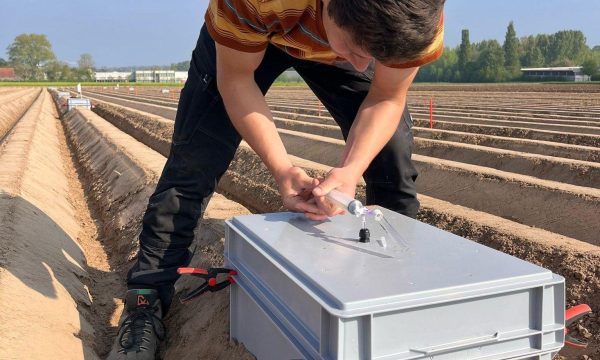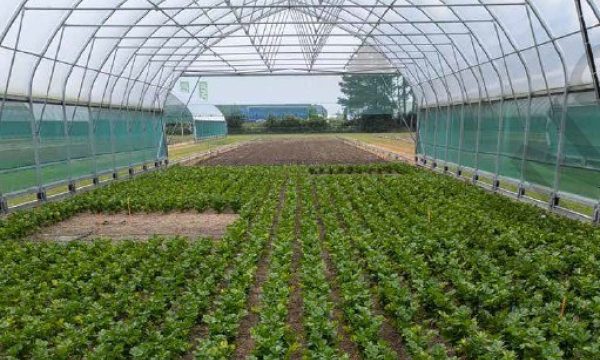Press release Male infertility in celery via asymmetric protoplast fusion can increase breeders’ efficiency and stability.

For the first time cells of celery and carrot were fused with each other and grown into viable adult plants. Once mature, it is possible that these fused plants will no longer be able to self-pollinate via their own stamens. Only another celery plant will then be able to fertilize them. This opens important possibilities for breeders. "Male sterility is very desirable when breeding hybrids because the whole point is to cross two parental lines in a very controlled and predictable way. And that is not easy when a plant can self-pollinate," says Silvia Bruznican, who recently completed her doctoral research. The technique she uses is also cheaper, faster or more effective than existing techniques to control pollination.
Whether the fused plant is actually male-sterile, and whether that sterility remains stable under all circumstances, must be investigated further. Now the protoplast-fusion technique has been successfully applied and the protocol is complete. From a scientific point of view these are important steps forward.
Silvia Bruznican recently defended her PhD: ' Tissue culture technology for asymmetric protoplast fusion in celery (Apium graveolens) and leek (Allium porrum)'. Supervisors are Prof. Dr. Ir. Danny Geelen of Ghent University, and Dr. ir. Johan Van Huylenbroeck and Dr. ir. Tom Eeckhout of Flanders Research Institute for Agriculture, Fisheries and Food (ILVO).
Preventing self-pollination to make F1-hybrids
Improved yield or improved plant characteristics are the goals of plant breeding. One way to achieve them is by creating inbred lines (by repeated rounds of self-pollination) with the desired characteristics, and then crossing those inbred lines with each other. From that intersection arise identical descendants with the desired, predictable properties – for growers and breeders the perfect match between mother and father line. For celery, these are for example plants that are uniform or disease resistant. These descendants are called F1-hybrids; it is their seed that breeders sell to growers.
During the making of the inbred lines (the mothers and fathers of the F1 hybrids) self-pollination has been necessary up to now. But once you want to cross two inbred lines with each other, the probability of self-pollination becomes a problem. Because a breeding line that pollinates itself ... makes a copy of itself. This can be avoided by making one of the two parent lines male sterile. That would be theoretically possible by manually clipping off the stamens, but that is not economically viable. Therefore breeders are seeking other techniques, such as cytoplasmic male sterilization (CMS). This creates a parent plant with a genetic defect in the cytoplasmic DNA (DNA in the plasma around the nucleus), which prevents the development of normal pollen.
Unfortunately, it takes a long time to create lines through CMS crossing. One alternative to CMS is genetic male sterilization (GMS), whereby an intervention is made in the nuclear DNA. But that technique is more expensive because GMS lines are difficult to maintain.
Development of new, stable CMS types is therefore very sought after in plant breeding. An option for this is alloplasmic CMS. Here, genetic material from one species is combined with genetic material from another. Concretely, the nucleus of the 'acceptor' is mixed with the cytoplasm of the 'donor '. This can be done via asymmetric protoplast fusion, the technique that ILVO-UGent researcher Silvia Bruznican has developed for celery.
Asymmetric protoplast fusion: peeling cells, mixing them up, and growing them into new plants
Bruznican has managed to create protoplasts (cells without cell walls) by peeling off the cell walls using chemical enzymes. Then she could disable or 'fragment' the nuclear DNA of carrot cells (donor) without compromising the cytoplasm using UV radiation. Conversely, she could inactivate the cytoplasm of celery cells (acceptor) without damaging the nuclear DNA, using a treatment with the chemical IOA (iodoacetamide). Then she took the nuclear DNA of the celery cells, and using chemical and electrical stimulation (polyethylene glycol and short electrical pulses), fused it to the cytoplasm of the carrot cells. This resulted in cells with asymmetric protoplasts: cells with the nucleus of celery and the cytoplasm of a carrot. Finally, she found a way to restore the cell wall of these merged cells and to let the cells grow into plants ('regeneration').

In Bruznican’s experiments, regeneration of all types of celery (white, green and celeriac) was successful Important here was the choice of the starting material; not all types of protoplasts can grow into full plants. The first shoots were formed 8-10 weeks after the fusion and 8 months after the start of the culture, the plants were removed from the lab and successfully planted in the field. For leek (the other part of the doctoral research) the regeneration of protoplasts was not successful.
Bruznican therefore focused on the cell fusion experiments in celery. It appeared that cell fusion with carrot cells was indeed possible, although the success depended on various parameters. Because successful fusion products are usually morphologically identical to the acceptor and thereby difficult to distinguish, Bruznican also developed cytoplasmic markers. That allows researchers to find out which precise DNA was exchanged, so interesting fusion products and be identified and used in further breeding.
The result of this doctoral research is that the protocol for protoplast fusion in celery has been perfected - an important step forward for celery breeding. Silvia Bruznican: "The potential of this technique for breeding and biotechnology is great, because unique genotypes can be created with it."
The male sterility of the fusion plants (celery with root) could not yet be tested. However, the regenerated plants from celery protoplasts (which are not fused) were screened for characteristics such as flower morphology, plant height and also male fertility. Within these characteristics a large variation was found, which may be interesting for breeders. That is why this research also represents an important scientific step forward for celery breeding. Now that the protocol has been perfected, the technique can be quickly introduced and widely applied, to other varieties as well. In addition, this new technique is easier and more efficient than removing stamens, faster than making crosses and cheaper than GMS, the alternative techniques to make plants male-sterile. That inspires dreams of more efficient, cheaper and faster breeding of F1 hybrid seeds for growers.


